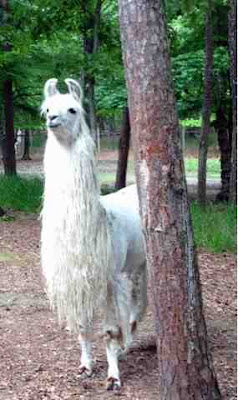In Love with Llama Fiber
For many years I’ve driven past a sign proclaiming "Carolina Llamas" that is found at the end of a long gravel driveway surrounded by woods. Despite the fact that this sign is within a few
miles of where I live, I'd never driven in to see what is there, but last week, after receiving an
invitation from a former school principal, I visited this farm, to learn a little about llamas and to, perhaps, buy some fiber or yarn.
I am subsequently both thrilled to have access to wonderful yarn and
fiber practically within a stone’s throw from my house and a bit apprehensive
about my ability to restrain myself from making one-too-many fiber shopping stops
at this all-too-convenient location.
A former co-worker and her year-old baby boy, Leonardo,
accompanied us on our visit. The
morning was a rare specimen of perfect Carolina springtime beauty—cool breeze,
bright sun, not-yet-dry-and-gone-to-seed fields, riotous flowers in bloom. We received a warm reception by the
enthusiastic and knowledgeable llama farm’s owner, Craig Swindler, who graciously led us around the large
establishment he runs with his wife, Janet. He
told us about llama fiber and the history of the llama’s origins and their relationship
to alpacas—apparently they share common ancestors and can interbreed. I also learned about the fiber from these creatures--the coarser guard hairs and
the superior fibers that are a desired product of breeding. We were all quite
awe-struck by the large national champion Lord of the Dance, the farm's prized male used for breeding purposes.
Swindler also placed a halter on a baby llama named
Saint and let us interact with him. It’s
amazing how young creatures have a natural affinity for one another. The baby llama and baby boy were equally curious
and amused by one another, and neither was squeamish about touching noses.
 |
| I had never spun llama fiber before and I am now a convert. My yarn is so much more consistent than that I've produced with other fibers. It's wonderfully soft, too. |
We concluded our visit to the farm by examining the yarn and bags of
fiber and roving for sale. While there
is not an actually store on the premises, the dining room table of the
Swindler's farmhouse serves that purpose.
Since the owners are retired, visitors are welcome to stop by any time.
To learn more about llamas, I read a little bit. I discovered that llamas were domesticated in
the highlands of Peru, approximately 3,000 to 4,000 years ago, making them
among the oldest domestic animals. The
llama was also worshipped by the Incas and also served as a pack animal and
source of clothing and food for these people.
Coincidentally, this past week, while planning to write about my llama
farm visit but a bit overwhelmed by grading odd bits of end-of-semester make-up
assignments and three class sets of literary analysis essays, I had the
opportunity to meet Neale Bayly, an individual with very close ties to
Peru. Neale is an adventure traveler and
motorcycle journalist who has ridden across 45 countries in 35 years.
During a motorcycle ride to Peru years ago, Neale was transformed by
the abandoned children he discovered being raised by eighty-year-old Sister
Loretta at the Hogar Belen orphanage. As a result of that experience, he formed
Wellspring International Outreach, a nonprofit dedicated to helping orphans
around the world. Check out the videos below about Neale's work and his
upcoming cable television program showing a grueling eight-day trek across
Peru.
NEALE BAYLY RIDES Trailer from Neale Bayly Rides on Vimeo.
 |
| At the end of the school year, I feel like running off and going on a motorcycle adventure. Maybe when I retire . . . |





I can definitely picture you going on an amazing motorcycle trip! I know very little about this culture, it is interesting to learn more. There are so many truly amazing people out there too! I am so excited about your trip to the farm! Oh how fun! Your handspun looks so pretty, I can only begin to imagine the wonderful things you could knit with it.
ReplyDeleteI would love to go on a motorcycle adventure too! :) That's cool that you have a llama farm just up the road and that they have fiber for you. Your handspun looks beautiful. I had seen alpaca fiber, but hadn't thought about llama fiber :D I did come across some camel fiber in the store once, it was really nice.
ReplyDeleteHow lovely to have llocal llamas! I know they have a reputation for being a bit bad-tempered and spitting sometimes but I like them and their yarn is lovely. Nothing wrong with dreaming of an adventure or two in my book - good for the soul! E x
ReplyDeleteHi there - it's been a while since I dropped by your blog - like you I've got lots of end of year bits and pieces to sort. Just when you think it's going to get easier they give you extra lessons to do - gifted and talented sessions and booster sessions. I love the photo of you with the bikers - you fit right in, and I can see you, a la Becky Sharpe, jumping on a bike on the final day of term, chucking your grade papers over your shoulder and heading off to Peru on an adventure. Looking forward to hearing what happens to your llama yarn - and is that your own spinning you are doing? Have you done an in-depth blog about spinning yet - and if not, can you give us a guided tour on how to spin please? It looks fascinating. How much yarn do you get from one bag of roving? V. interesting post. Judy.
ReplyDelete